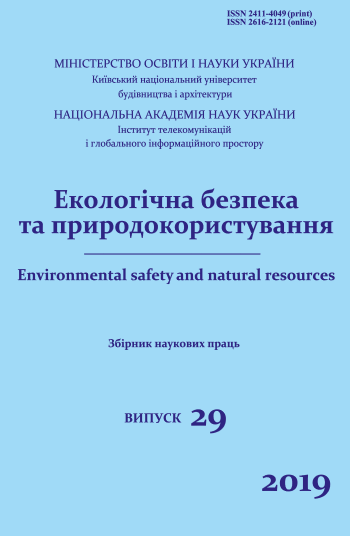Еnvironmental hazards of the mining and chemical enterprises territory
DOI:
https://doi.org/10.32347/2411-4049.2019.1.40-53Keywords:
mining and chemical enterprise, heavy metals, reclamation, environmental hazard, water pollution, soil pollutionAbstract
The ecological situation in most mining regions n Ukraine is critical, and the closure of unprofitable mining enterprises, mines and cuts creates environmental problems associated with significant changes in the geological and hydrological environment.
The purpose of the work is to assess the environmental hazard of the territory of the Rozdil State Mining and Chemical Enterprise "Sirka".
The research was carried out on the territory of Rozdil SMCE “Sirka”. Rozdil State Mining and Chemical Enterprise “Sirka” is in the West of Ukraine (Lviv region) of the Dniester River basin. According to the State Register of Potentially Hazardous Objects (PHO) of Ukraine, Rozdil State Mining and Chemical Enterprise "Sirka" belongs to the monitoring facilities of PHO.
The X-Ray Diffraction (XRD) method was used experimentally to determine the qualitative and quantitative composition of heavy metals and other inorganic elements in samples, soil pollution with heavy metals. The main threats were identified which should be considered at the stage of liquidation of the mining and chemical enterprise. The main reason for pollution of the water objects of the enterprise territory and the Dniester River is the non-performance of the project on maintenance of ecological balance, monitoring, reclamation of the territory of the land due to lack of financing for the implementation of projects. In this regard, sources of pollution (phosphogypsum, oil tars, lump sulfur, flotation tails, solid waste) constantly affect the environment and over the years the situation is still dangerous. On the example of Rozdil State Mining and Chemical Enterprise "Sirka" the main problems of the monitoring system of the territory of the mining and chemical enterprise at the stage of liquidation are demonstrated. The influence of the mining and chemical enterprise on the state of pollution of the environment: soil, water environment, and waste management status were also assessed.
Also, according to the obtained data, in the man-made reservoirs of the enterprise (Lake Hlyboke, Lake Serednie, Lake Chyste, channels), which flow into the Dniester River, an excess of the MPC is seen in many hydrochemical parameters: pH, sulfates, phosphates, ammonium nitrogen, etc.
References
Trunova, I. O. (2008). Tekhnohennyi vplyv elementiv kadmiiu ta svyntsiu, shcho mistiatsia u vidvalakh fosfohipsu, na navkolyshnie seredovyshche (Doctoral dissertation) [Abstract] (in Ukrainian).
Ukraine, Verkhovna Rada Ukrainy. (1998, March 5). Postanova №188/98-VR «Osnovni Napriamy Derzhavnoi Polityky Ukrainy U Haluzi Okhorony Dovkillia, Vykorystannia Pryrodnykh Resursiv Ta Zabezpechennia Ekolohichnoi Bezpeky». Retrieved from http://zakon5.rada.gov.ua/laws/show/188/98-bp/page (in Ukrainian).
Rybicka, E. H. (1996). Impact of mining and metallurgical industries on the environment in Poland. Applied Geochemistry, USA, 11(1-2), 3-9.
Razo, I., Carrizales, L., Castro, J., & Monroy, M. (2004). Arsenic and Heavy Metal Pollution of Soil, Water and Sediments in a Semi-Arid Climate Mining Area in Mexico. Water, Air, and Soil Pollution, USA, 152(1-4), 129-152.
Wenshen, L., Xiaowen, G., & Jie, L. (2018). Bitumen recovery from Indonesian oil sands using ASP (alkali, surfactant and polymer) agent. China Petroleum Processing and Petrochemical Technology, 20, 110-115.
Ukraine, VAT «HIRKhIMPROM». (2008). Zvit pro NDR «Zavershennia rozrobky Oblasnoi Prohramy povodzhennia z toksychnymy vidkhodamy» (in Ukrainian).
Ukraine, MNS. (06.11.03). Nakaz №425 „Pro zatverdzhennia Polozhennia pro monitorynh potentsiino nebezpechnykh obiektiv” (in Ukrainian).
Biliavskyi, H. O., Padun, M. M., & Furdui, R. S. (1995). Osnovy zahalnoi ekolohii: Pidruchnyk (2 zi zminamy ed.). Kyiv: Lybid (in Ukrainian).
Ukraine, Mykolaivskа raionnа derzhavnа administratsiiа. (2012, January 25). Rozporiadzhennia № 44 Pro Konservatsiiu Zemel Rozdilskoho DHKhP «Sirka». Retrieved from http://mykolaiv-rda.lviv.ua/dokumenti-rda/rozporjadzhennja/item/2693-№-44-pro-konservatsiyu-zemel-rozdilskogo-dghp-sirka.html (in Ukrainian).
Bilous, L. B., & Chopyk, Y. O. (2002). Problemy monitorynhu vyrobnycho-ekolohichnykh terytorialnykh system hirnychoho pidpryiemstva. Ukrainskyi Derzhavnyi Lisotekhnichnyi Universytet, Naukovyi Visnyk, (12.1), 164-174 (in Ukrainian).
Kopach, P. I., Horobets, N. V., Danko, T. T., & Bondarenko, L. V. (2009). Osnovni polozhennia metodolohii stvorennia systemy monitorynhu navkolyshnoho seredovyshcha hirnychodobuvnykh rehioniv. Ekolohiia I Pryrodokorystuvannia, 12, 181-187 (in Ukrainian).
Gajdyn, A. M., Kovalyshyn, V. V., & Saliuk, I. V. (1999). Project of reclamation of disturbed lands, the basic project decisions of restoring the ecological balance of the landscape through the phased withdrawal capacity of careers and their liquidation. Lviv, Ukraine (in Ukrainian).
Rudko, G., & Shkitsa, L. (2002). Ecological consequences of the activity of Western Ukraine mining complexes. Wiertnictwo Nafta Gaz, Poland, 19/2, 415-418.
Poberezhna, L. I. (2016). Otsinka ekolohichnykh ryzykiv v raionakh likvidovanykh hirnycho-khimichnykh pidpryiemstv (na prykladi m. Kalush) (Doctoral dissertation, Ivano-Frankiv. nats. tekhn. un-t nafty i hazu) [Abstract] (in Ukrainian).
Fetzer, J. C. (2014). Mass Spectral Detection. In Handbook of Spectroscopy. doi:10.1002/9783527654703.ch49
Gauglitz, G., & Moore, D. S. (Eds.). (2014). Handbook of Spectroscopy (2nd ed., 4 vols., Analytical and Bioanalytical Chemistry 406(29)).
Epp, J. (2016). X-Ray Diffraction (XRD) Techniques for Materials Characterization, Materials Characterization Using Nondestructive Evaluation (NDE) Methods. doi:10.1016/B978-0-08-100040-3.00004-3
Pohrebennyk V., Mitryasova O., Kłos-Witkowska A., & Dzhumelia E. (2017). The role of monitoring the territory of industrial mining and chemical complexes at the stage of liquidation. In 17th International Multidisciplinary Scientific GeoConference SGEM, (Vol. 17, issue 33, pp. 383–390). Vienna, Austria.
Lomnytska, Y. F., Vasylechko, V. O., & Chykhrii, S. I. (2011). Composition and chemical control of environmental objects. Lviv, Ukraine: «Novyi Svit-2000».
Bryk M., & Kołodziej B. (2009). Reclamation problems for the area of a former borehole sulfur mine with particular reference to soil air properties, Land Degrad. Dev., 20, 509-521.
Pohrebennyk, V., Dzhumelia, E., Korostynska, O., Mason, A., & Cygnar, M. (2016). Technogenic Pollution of Soil due to Mining and Chemical Enterprises. In 16th International Multidisciplinary Scientific GeoConference SGEM, (Vol. 2, pp. 363-370). Albena, Bulgaria.
Schults, D. (1996). Recultivation of mining waste dumps in the Ruhn Area, Germany. Water, Air and Soil Pollution, 91(1/2), 89-98.
Downloads
Published
How to Cite
Issue
Section
License
Copyright (c) 2019 Volodymyr D. Pohrebennyk, Elvira A. Dzhumelia

This work is licensed under a Creative Commons Attribution 4.0 International License.
The journal «Environmental safety and natural resources» works under Creative Commons Attribution 4.0 International (CC BY 4.0).
The licensing policy is compatible with the overwhelming majority of open access and archiving policies.

